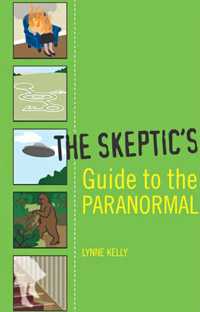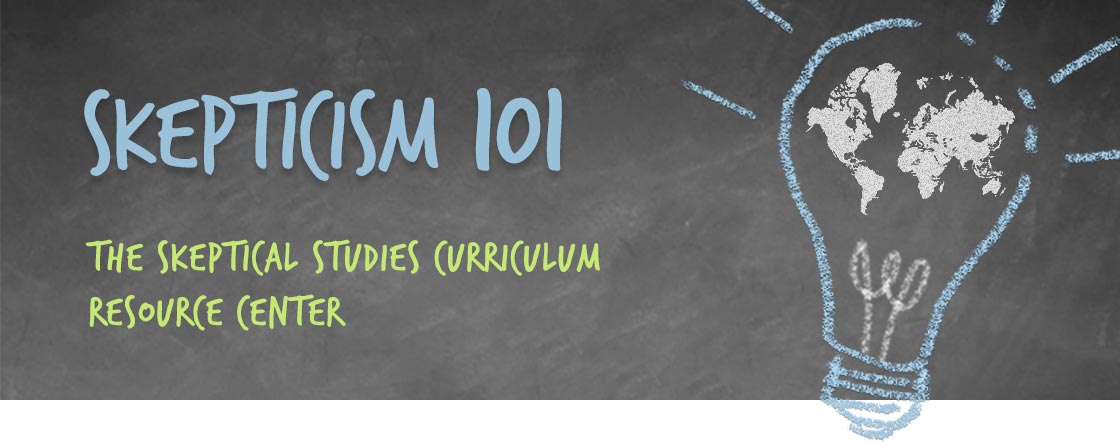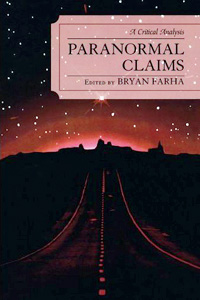You Are Browsing Resources on:
cryptozoology and supernatural beings
This course was taught at Florida State College at Jacksonville during the spring 2013 semester.
Excerpt from Syllabus
An interdisciplinary study of selected topics in the biological and physical sciences and their impact upon man and society, with the course format including seminar, discussion and projects. Topics will vary…. genetics, tissue culture, space, Malthusian theory, light, sound, and mechanics. This course will provides students with a unique opportunity to examine many common pseudoscientific fallacies, learn how the human brain has evolved to encourage paranormal beliefs, and challenge the students to confront their own biases as they apply the scientific method to their own beliefs through in-class activities, experiments, and research projects.
DOWNLOAD THIS RESOURCE
(150 kb PDF)
This PowerPoint is part of a course titled, “Science Skepticism & Weird Behavior.”
SCIENCE, THEORY, AND PARADIGM SHIFTS
There are three lectures in this series, they are intended to educate students about the nature of science and the power of natural explanations. This is accomplished through the concept of the Paradigm Shift. The discussion begins with non-scientific views of nature and then follows the development of scientific views and how/why they changed over many hundreds of years. This post concerns the second lecture in the series.
Examples of paradigm shifts covered in the lecture series include:
- the shift from supernatural to nature interpretations of comets.
- the shift from astrology (Ptolemaic) to astronomy (Copernican revolution).
- the development of Copernican cosmology to a synthesis called Newtonian physics.
- the shift from Newtonian physics into Relativity Theory.
Lecture 2 – PARADIGM SHIFT 2
This lecture introduces the concept of scientific paradigm shifts, the concept of empiricism, the concept of anomalies and the concept of synthesis. These concepts are discussed in the context of a paradigm shift called the Copernican and the Newtonian Revolutions.
DOWNLOAD THIS RESOURCE
(20.6 MB Powerpoint Presentation)
Lecture 1 – PARADIGM SHIFT 1
You can find the first lecture in the series here.
Lecture 3 – PARADIGM SHIFT 3
You can find the third lecture in the series here.
This course was taught at the University of Texas at El Paso during the spring 2013 semester.
Excerpt from Syllabus
This course is designed to introduce students to a variety of critical thinking skills and to encourage them to practice those skills in the context of evaluating popular claims, especially extraordinary claims about topics relevant to anthropology and archeology. It is intended for students who are attracted to the interesting topics identified with anthropology in the popular media, but the level of instruction assumes no prior experience in anthropology. Students will learn about the methods used to interpret the physical traces of behavior, and how to distinguish scientific arguments from pseudoscience and non-science. Lectures, readings and class exercises will examine a variety of non-scientific explanations for past and present events, such as UFOs and ancient astronauts, Bigfoot, pyramid power, Atlantis, creationism and intelligent design, the Book of Mormon, dowsing, climate change denial, and psychic archeology.
Does Bigfoot roam the mountains of Oregon, and do his cousins hang out in the Sacramento Mountains of southern New Mexico? Are they shape-shifters, or do they use wormholes to travel the time-space continuum? Are extraterrestrial aliens like the ones who crashed in Roswell, New Mexico silvers or greens? Is there really an exotic blood-sucking animal called chupacabra killing livestock in the southern U.S. and northern Mexico, or is it just a hairless raccoon? Should we believe Senator James Inhofe when he says that global climate change is a hoax? Is cell phone use harmful to your health? Do the Power Balance bracelets worn by Drew Brees and Kobe Bryant provide any real scientific advantage to athletes? Are modern humans related to ancient prehistoric peoples, or were we created in modern form? Is there reliable evidence to support the claims that psychics can reveal details about the past or make valid predictions about the future? Was planet earth really visited by ancient astronauts, and did they teach Egyptians how to build the pyramids? How can we know the answers to such questions? In fact, how can we know the truth about any claim? We are bombarded by information and claims all the time, and it is vitally important, now more than ever, that we be able to distinguish valid information and warranted conclusions from those that are not. How can we do this, especially when the claims involve events that occurred in the prehistoric past, were not witnessed by humans, or were not documented in written records?
DOWNLOAD THIS RESOURCE
(4 MB PDF)
This book was required reading for Martin Bridgstock’s course, “Skepticism, Science, & the Paranormal” taught at Griffith University.

Can a human being really spontaneously burst into flames? Just how deadly is the Bermuda Triangle? And what’s the real story behind all those alien abductions? The answers to these and many other questions lie within the covers of The Skeptic’s Guide to the Paranormal. Guaranteed to liven up any dinner party, this delightful, highly readable book offers color photographs and scientific case-by-case explanations for twenty-seven phenomena that appear to defy known science, including ghosts and poltergeists, the predictions of Nostradamus, and yogic levitation, among many others. Speaking directly to the reader, and always with respect for those who believe, Kelly gives us a bite-size, nonacademic approach to debunking hugely popular superstitions and mysteries. Did you know that you, too, can bend spoons and read minds? This book will show you how. —Publisher
BUY THIS BOOK
from Amazon
This book was required reading for Dr. Bryan Farha’s course, “Sociology of Belief” taught at Oklahoma City University during spring 2011.
Published in April of 2007, this academic text features articles regarding paranormal, extraordinary, or fringe-science claims. It logically examines the claims of astrology; psychic ability; alternative medicine and health claims; after-death communication; cryptozoology; and faith healing, all from a skeptical perspective. Paranormal Claims is a compilation of some of the most eye-opening articles about pseudoscience and extraordinary claims that often reveal logical, scientific explanations, or an outright scam. These articles, steeped in skepticism, teach critical thinking when approaching courses in psychology, sociology, philosophy, education, or science. —Amazon
BUY THIS BOOK
from Amazon











